“O du lieber Augustin, Augustin, Augustin,
O du lieber Augustin, alles ist hin.“
Viennese folk song
Everything you knew about cigarettes and tobacco smoke is wrong. We now know for a fact that it protects against COVID-19, as French scientists recently discovered. While cigarettes smoke is theoretically bad, the carbon monoxide (CO), product of tobacco combustion (and car exhausts) is actually not the dangerously lethal gas we all assumed it to be. It is actually very healthy, even up to protecting the cigarette smoker, and when applied under medical supervision, it can cure many diseases. No wait, come back, you illiterate science denialists.
The highest scholarly authority in all things chemistry, the American Chemical Society (ACS), brought this magazine article in November 2019:

Now listen and learn: US scientists have discovered in a number of peer reviewed papers in highly respectable learned society journals that inhaled CO gas activates protective molecular pathways in lung and epithelial cells, thus bound to cure various diseases. The only surprising thing for me is that the article was not updated with a proposal to treat COVID-19 with carbon monoxide inhalation, since it might significantly end the disease progression by eliminating the patient.
But in any case, before you run outside to smoke a quick healthy ciggie, or to suck on a car’s exhaust tube to cure your coronavirus infection, let me introduce you to the eminent US-Korean clinical researcher who discovered the magically curative properties of carbon monoxide on lungs and other organs.
Meet Professor Augustine MK Choi, Dean of the Weill Cornell Medical School and Provost for Medical Research at the Cornell University in Ithaca, New York. In his lectures, the pulmonology expert extols every year the medicinal virtues of carbon monoxide inhalation, in fact every disease in every organ can be cured by carbon monoxide, as Choi himself explains:
“There is no molecule that’s been shown to be this cytoprotective in just about every organ tissue injury—brain, lung, pancreas, heart, kidney, you name it“
Choi trained in Duke and Harvard and has been professor everywhere: Johns Hopkins University, Yale, Pittsburgh and then Harvard, but none of those could satisfy him enough. In 2013, he moved to Weill Cornell, where he became dean in 2017. In 2011, he received the Ho-Am Prize in Medicine, in his CV Choi explains:
“The Ho-Am Prize, often referred to as the Korean equivalent of the Nobel Prize, is awarded to “ethnic Koreans who have made outstanding contributions to the development of science and culture and enhancement of the welfare of mankind”
The reason Choi feels like a Nobel Prize winner, is that his gaseous discovery of CO therapy somehow connects him to Louis Ignarro, winner of the Nobel Prize for the discovery of the physiological function of the nitric oxide (NO) gas. The comparison to Nobelist Ignarro is more apt than even Choi himself would suspect!
A genius and a true visionary of science, this Professor Choi, you are surely convinced now, while lighting up a cigarette. But now, please allow me, with the kind help from Clare Francis, to introduce you to the preclinical research behind these CO discoveries.
There are presently over 30 Choi papers discussed on PubPeer. Let us start with a vintage classic, which Augustine Choi published together with his wife, Mary E Choi, nephrology professor and his close collaborator at same Weill Cornell. The work was done over 20 years ago back at Johns Hopkins University in Baltimore.
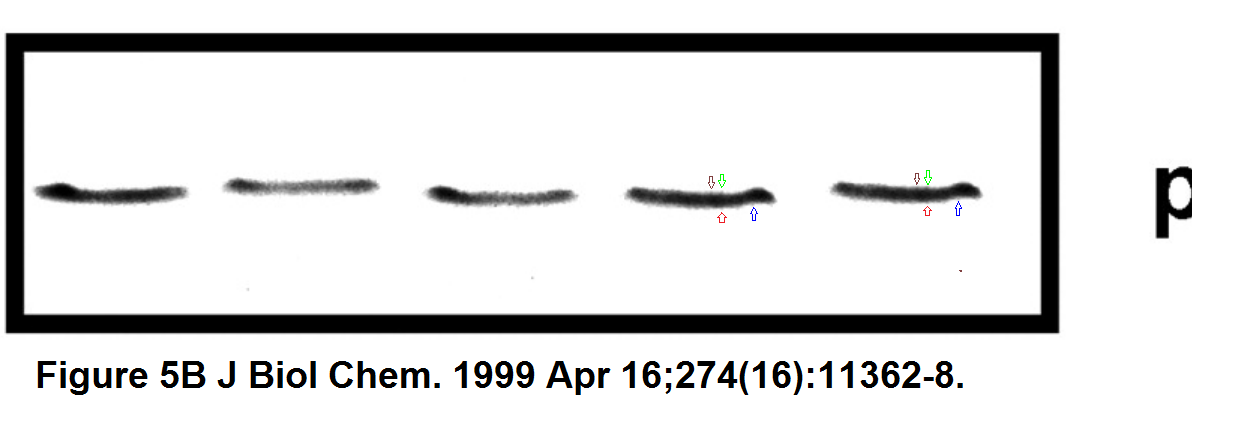
Beek Yoke Chin, Irina Petrache, Augustine M. K. Choi, Mary E. Choi Transforming growth factor beta1 rescues serum deprivation-induced apoptosis via the mitogen-activated protein kinase (MAPK) pathway in macrophages Journal of Biological Chemistry (1999) doi: 10.1074/jbc.274.16.11362
The last two bands are most certainly cloned, the little arrows highlight the identifying similarities. The gel image also lacks background, likely to hide all traces of digital manipulation. The first author Beek Yoke Chin is now a star scientist back in his home country Malaysia, celebrated as “Professor with a passion to make a difference“.
Here another paper by same Dr Chin, again with his mentor Mr and Mrs Choi. That paper offers a whole menu selection of western blot fakeries.
Beek Yoke Chin, Amir Mohsenin, Su Xia Li, Augustine M. K. Choi, Mary E. Choi Stimulation of pro-alpha(1)(I) collagen by TGF-beta(1) in mesangial cells: role of the p38 MAPK pathway American journal of physiology. Renal physiology (2001) doi: 10.1152/ajprenal.2001.280.3.f495

These gel bands were copy-pasted very lazily, because 20 years ago, nobody paid much attention to data integrity. And why should anyone, it was the Golden Age of the Photoshop. Western blots are often ridiculed as a bad method, and criticised for being a source of fraud. Which in my view is weird, since the very reason so much uncovered fraud evidence is based on western blots is because these results, unlike all other molecular biology methods, are very difficult to fake digitally.
But I still have not shown you any CO-related research, so now it comes. Below, the Choi lab has been reusing western blot bands not just inside a paper, but between papers.
Ruiping Song, Raja S. Mahidhara, Fang Liu, Wen Ning, Leo E. Otterbein, Augustine M. K. Choi Carbon monoxide inhibits human airway smooth muscle cell proliferation via mitogen-activated protein kinase pathway American Journal of Respiratory Cell and Molecular Biology (2002) doi: 10.1165/rcmb.4851
Ruiping Song, Wen Ning, Fang Liu, Bill T. Ameredes, William J. Calhoun, Leo E. Otterbein, Augustine M. K. Choi Regulation of IL-1beta -induced GM-CSF production in human airway smooth muscle cells by carbon monoxide AJP Lung Cellular and Molecular Physiology (2003) doi: 10.1152/ajplung.00212.2002
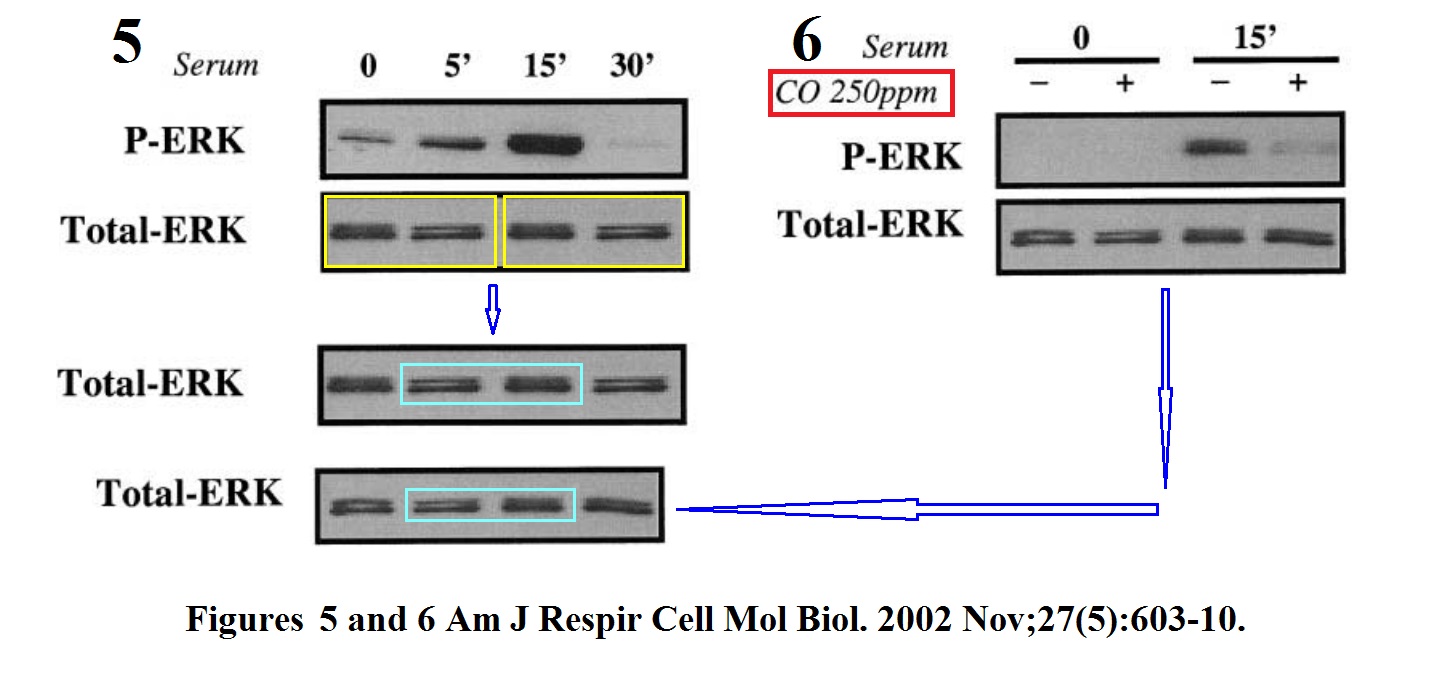
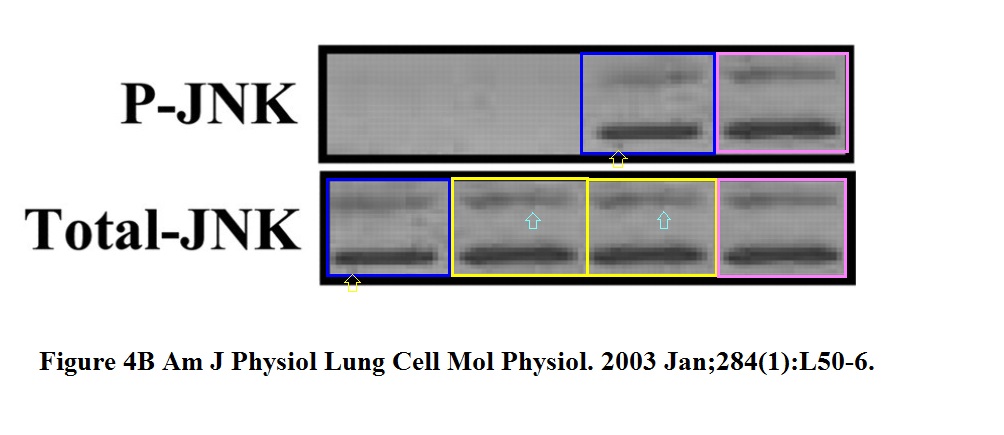
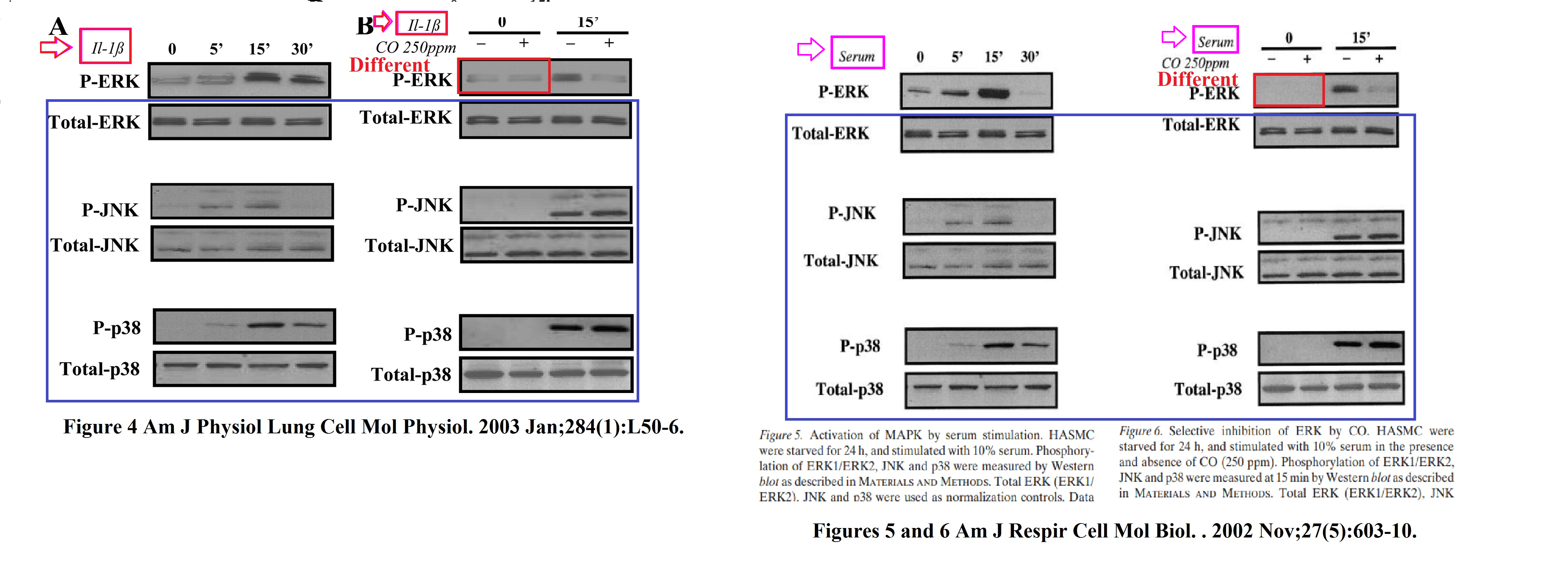
It doesn’t look nice at all when whole western blot panels are reused in another paper to represent a different experiment, with different treatments. And then there also gel bands, cloned inside and between gels. In better news, Choi is Associate Editor in the American Journal of Respiratory Cell and Molecular Biology, published by the American Thoracic Society, where he held several leadership positions, so it will be him and his friends deciding about a correction which will not be needed anyway.
The significant co-author and Choi-mentee behind those gel fabrications adventure is Leo Otterbein, now Harvard professor at Beth Israel Deaconess Medical Center (where Pier Paolo Pandolfi used to be). This Choi’s PhD graduate is credited as co-discoverer of the CO therapy, STAT wrote in 2017 “Exactly who came up with this idea remains a contentious point between the two scientists today“. Otterbein is also a businessman, acting as principal scientific advisor for the CO-therapy marketing company Hillhurst. He has been cited in the aforementioned ACS magazine article:
“There’s been enough preclinical data,” says Leo E. Otterbein, who studies the physiological effects of CO at Harvard Medical School. “The time has come—the time is past—to get this into humans and at least see if it works.”
Enough data there has been indeed, but which kind of data, Professor Otterbein? The fabricated kind? Not really in agreement with your Hippocratic Oath to make patients inhale a deadly gas based on such “preclinical data”. Like this here:

Tamás Dolinay, Mária Szilasi, Mingyao Liu, Augustine M. K. Choi Inhaled carbon monoxide confers antiinflammatory effects against ventilator-induced lung injury American Journal of Respiratory and Critical Care Medicine (2004) doi: 10.1164/rccm.200401-023oc
It does very much look like a cloned gel band again, which sure could save the lives of many COVID-19 patients on ventilators. The first author and pulmonologist Tamas Dolinay is now employed by UCLA Santa Monica. Before we continue with Professor Choi’s carbon monoxide research, the following quote from Otterbein is hilarious, it was published by ACS magazine unironically though. It refers to his PhD advisor Choi:
““I’ll never forget this one guy,” Otterbein recalls. After he gave his first talk at a conference, a man from the US Environmental Protection Agency stood up in the audience and denounced his work, fuming that his results reflected a nonspecific response and that his work would never be clinically relevant because it proposed to expose people to unsafe levels of CO. Back at Johns Hopkins, colleagues were similarly unsupportive. “My dissertation committee said to pick a different topic,” Otterbein says. “They said, ‘This is stupid; don’t waste your time.’ ”
My personal theory is that this exact anti-science denialism is what prevents us from having a COVID-19 cure. If only the world would finally accept Professor Choi’s wisdom about the amazing healing effect of carbon monoxide, especially on lungs. Doesn’t it stand to reason that CO must be the ultimate cure for the coronavirus infection, since it worked so well in Photoshop?
But because of all that medieval animosity towards what is merely one of the most toxic gases, we can’t have good things.
Of course Professor Choi himself set up his own business to peddle CO as therapeutic inhalation gas. The company Proterris which Choi founded together with the cardiologist David Pinsky from the University of Michigan, has also been celebrated by the ACS article. Proterris already developed a ventilating device which can stream admixed CO into patients’ lungs. Go ahead, try it.

Ready for some more research into carbon monoxide? Now, according to the wise Professor Choi, inhaled CO exerts its “anti-apoptotic, anti-inflammatory, and anti-proliferative properties” in lung and blood vessel cells by activating the enzyme heme oxygenase-1. And this is the research behind it:
Xue Wang, Yushen Zhou, Hong Pyo Kim, Ruiping Song, Reza Zarnegar, Stefan W Ryter, Augustine M K Choi Hepatocyte growth factor protects against hypoxia/reoxygenation-induced apoptosis in endothelial cells Journal of Biological Chemistry (2004) doi: 10.1074/jbc.M309271200
Hong Pyo Kim, Xue Wang , Zhi-Hua Chen , Seon-Jin Lee , Min-Hsin Huang , Yong Wang , Stefan W Ryter , Augustine M K Choi Autophagic proteins regulate cigarette smoke-induced apoptosis: protective role of heme oxygenase-1 Autophagy (2008) doi: 10.4161/auto.6767

Confusing, isn’t it? What are those gel bands doing jumping inside and between two, no wait, three, no, four different papers? They are proving to you that carbon monoxide is healthy, that’s what they do. You might notice that I listed only two of these 4 papers above, that is because the other two papers are also part of a bigger block with two more papers in the next instalment of Professor Choi’s Carbon Monoxide Orgy.
Xue Wang, Yong Wang, Seon-Jin Lee, Hong Pyo Kim, Augustine MK Choi, Stefan W Ryter Carbon monoxide inhibits Fas activating antibody-induced apoptosis in endothelial cells Medical Gas Research (2011) doi: 10.1186/2045-9912-1-8
That journal was sold by BioMedCentral in 2015, maybe because Medical Gas Research used to publish such insane garbage like Otterbein’s 2013 editorial “Quoth the Raven: carbon monoxide and nothing more“, which addressed the ill health and death of the poet Edgar Allen Poe and where Otterbein concluded with an an urgent need “to move inhaled carbon monoxide into clinical application as a therapeutic.“
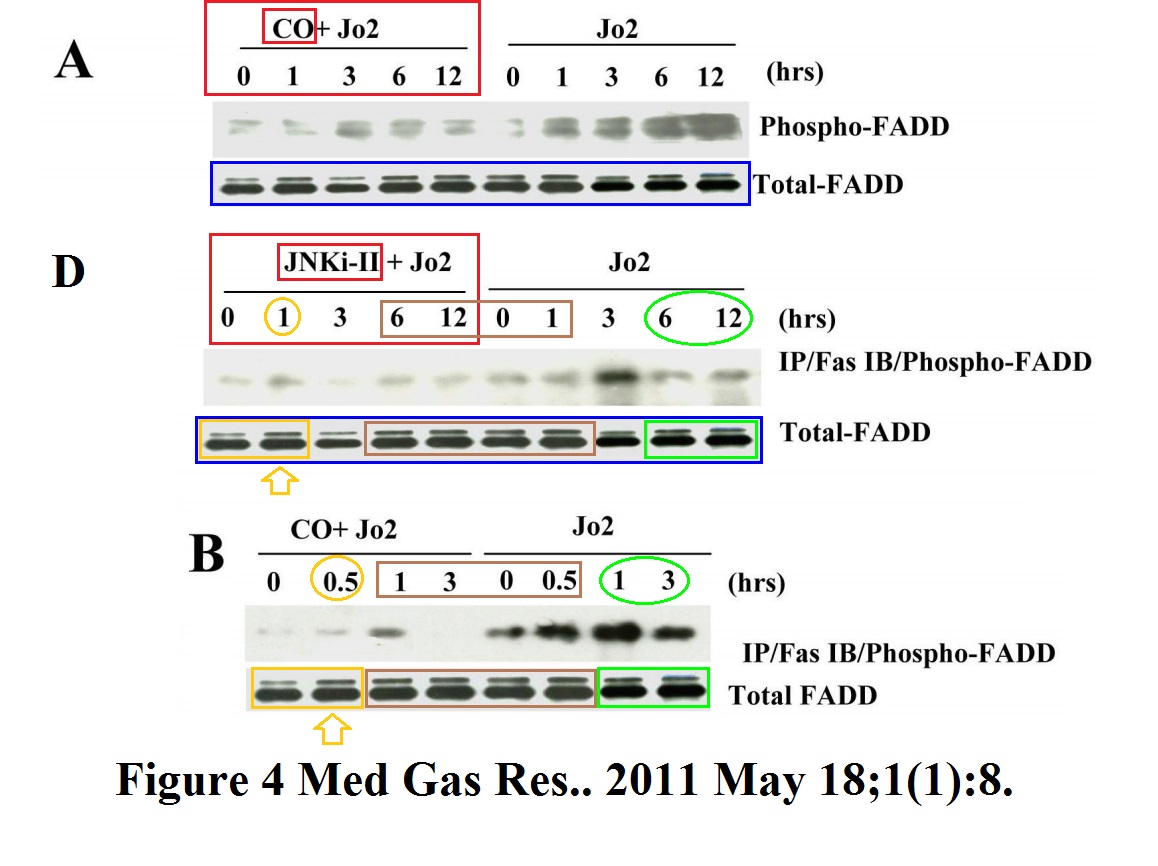
Update 25.08.2020: that Wang et al 2011 paper will be retracted, as Editorial Office of Medical Gas Research wrote to Clare Francis (highlight theirs):
“Dear Dr. Claire Francis,
After discussion and based on the evidence you provided, the Editorial Office of Medical Gas Research has determined to retract the manuscript.
According to the COPE flowchart for suspected plagiarism in a published manuscript, we’ve contacted the corresponding author in writing, the author’s responses are expected to be sent back before the end of August.
The retraction will be announced once we received the author explanation.“
Update 6.01.2021. The retraction is apparently cancelled. The Medical Gas Research editorial office informed Clare Francis:
“To follow the guidelines by COPE, we have contacted the corresponding author Dr. Stefan W. Ryter to address the questions. Based on the author’s response, the editor-in-chief decided to give him another chance to repeat the experiment using the orginal [sic] conditions and to verify the validity of the original findings afterwards. […] We will inform you the final decision by the editor-in-chief either an erratum or retraction note will be placed with the article based on the new figure the author provided.“
This is Ryter’s Corrigendum, where “The results as follows are submitted to replace the original data in the manuscript and do not change the scientific interpretation of the manuscript.“
These are the other 3 papers of Choi’s lab fraudulent quadriga:
Xue Wang, Yong Wang, Jinglan Zhang, Hong Pyo Kim, Stefan W. Ryter, Augustine M. K. Choi FLIP protects against hypoxia/reoxygenation-induced endothelial cell apoptosis by inhibiting Bax activation Molecular and Cellular Biology (2005) doi: 10.1128/mcb.25.11.4742-4751.2005
Xue Wang, Yong Wang, Hong Pyo Kim, Kiichi Nakahira, Stefan W. Ryter, Augustine M. K. Choi Carbon monoxide protects against hyperoxia-induced endothelial cell apoptosis by inhibiting reactive oxygen species formation Journal of Biological Chemistry (2007) doi: 10.1074/jbc.m607610200
Dirk-Jan Slebos, Stefan W. Ryter, Marco Van Der Toorn, Fang Liu, Fengli Guo, Catherine J. Baty, Jenny M. Karlsson, Simon C. Watkins, Hong Pyo Kim, Xue Wang, Janet S. Lee, Dirkje S. Postma, Henk F. Kauffman, Augustine M. K. Choi Mitochondrial Localization and Function of Heme Oxygenase-1 in Cigarette Smoke–Induced Cell Death American Journal of Respiratory Cell and Molecular Biology (2007) doi: 10.1165/rcmb.2006-0214oc
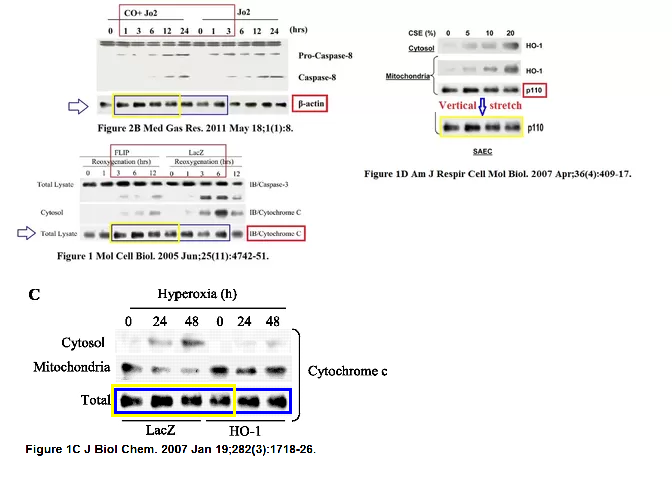
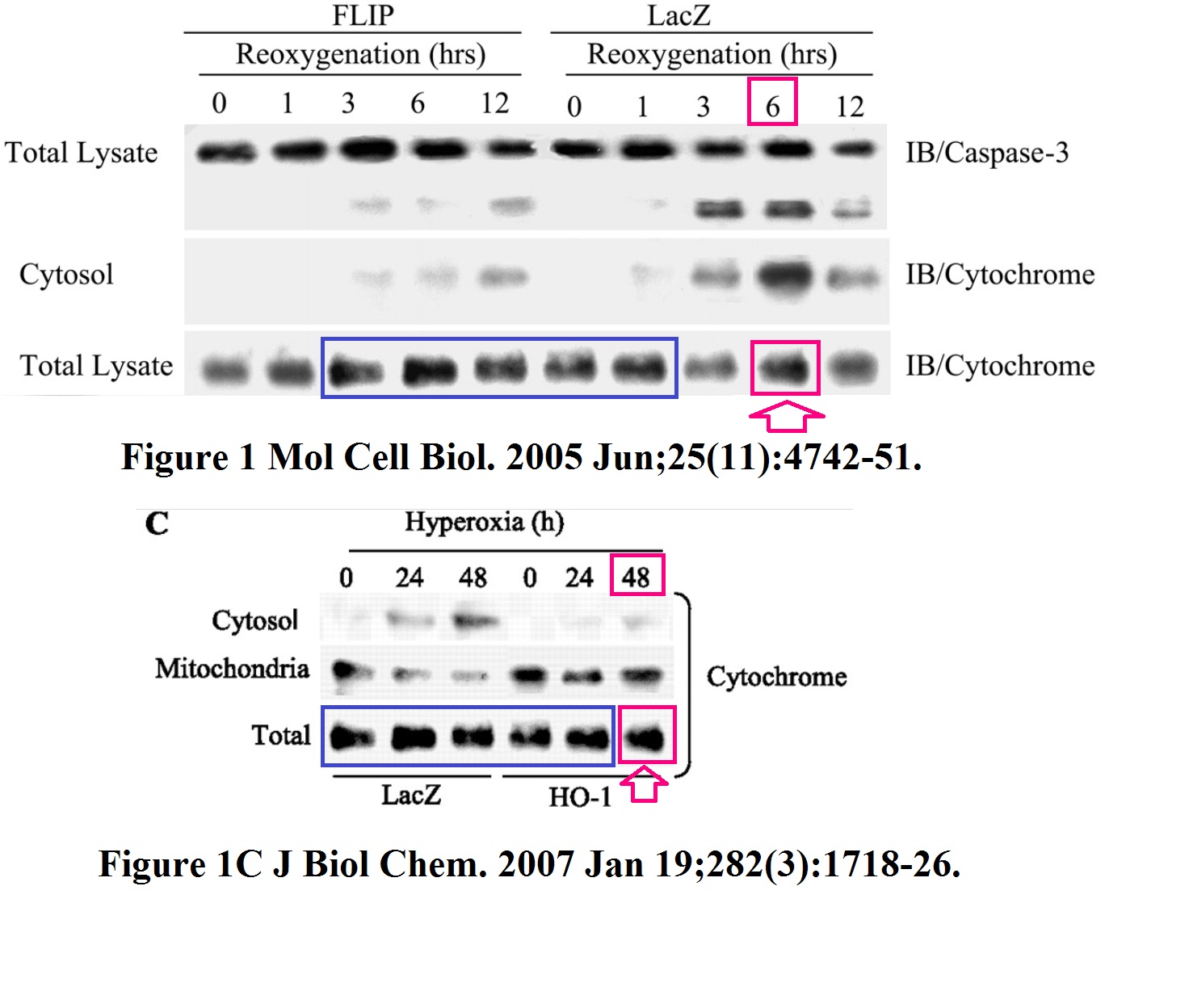
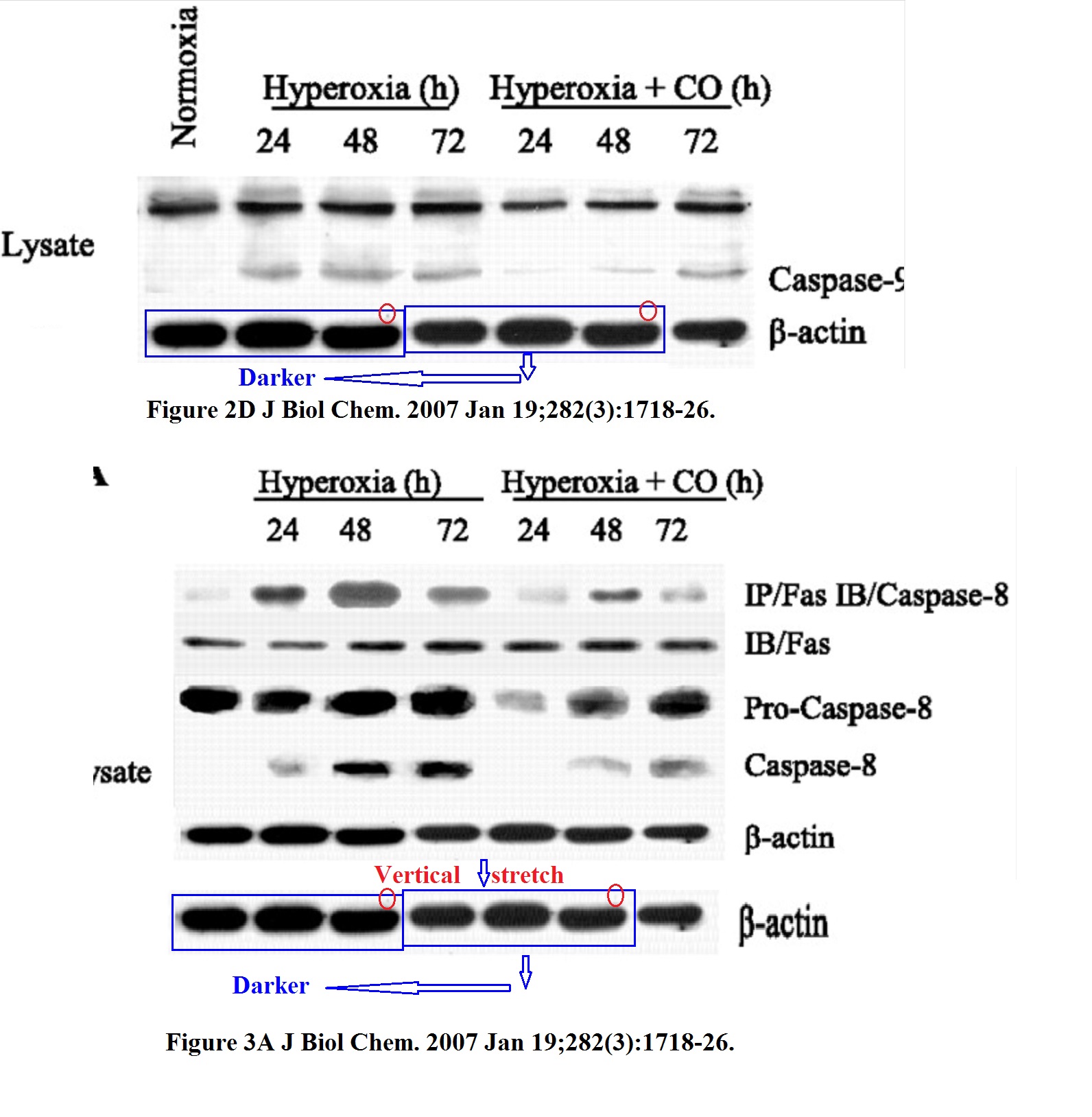
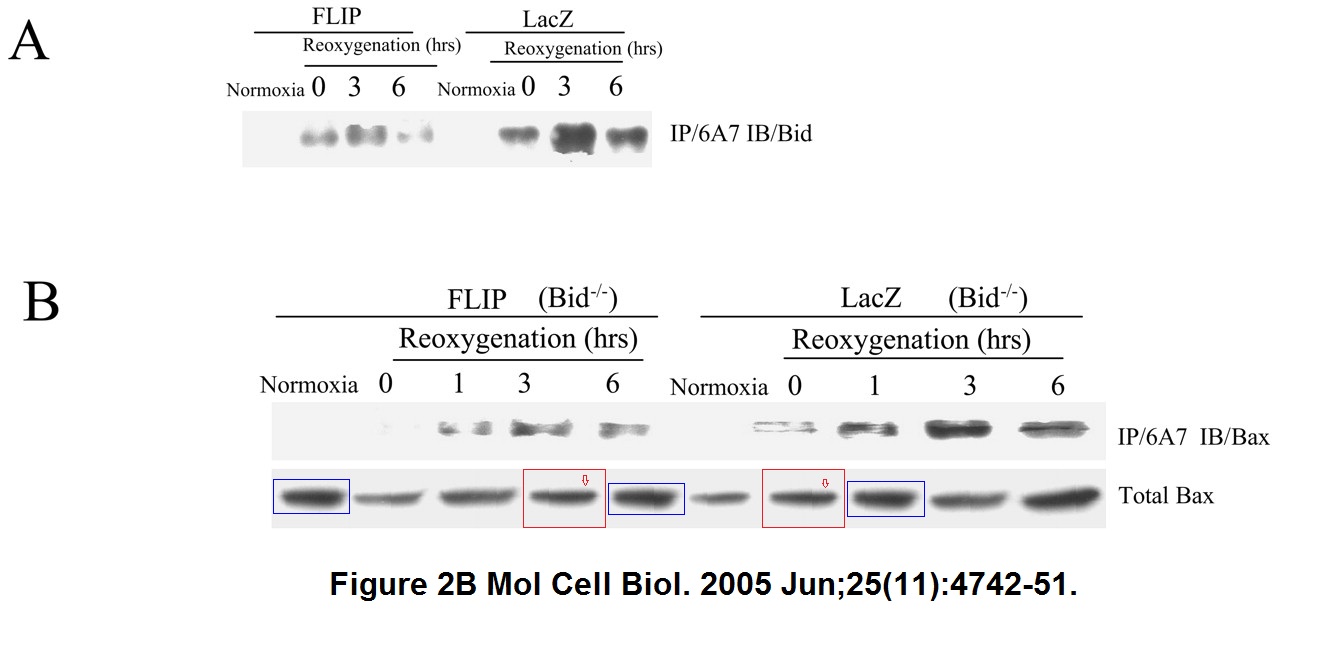
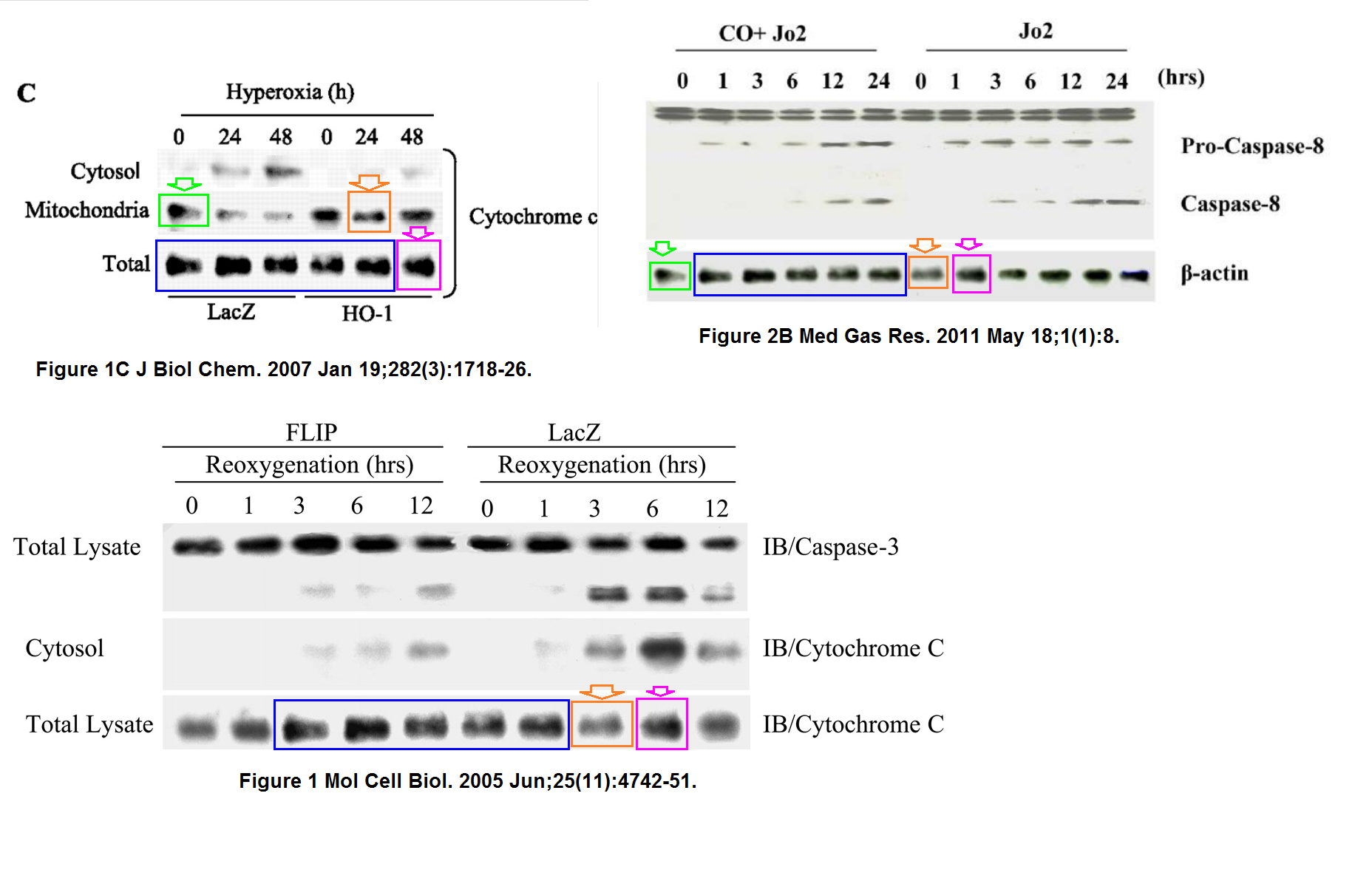
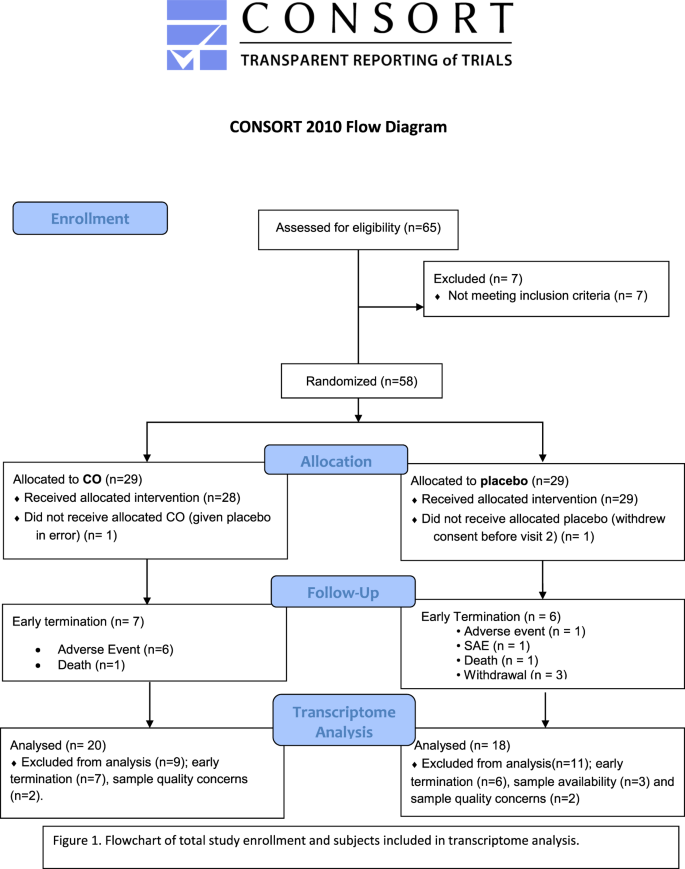
The significant co-author on all these 6 utterly fabricated papers is Stefan Ryter , now assistant professor and program director at Brigham & Womens Hospital at Harvard. As it happens, Ryter was involved in a phase 2 clinical trial at Brigham & Womens, on behalf of Choi. It produced no significant effect for CO versus placebo, but some adverse events in the patients with idiopathic pulmonary fibrosis (Casanova et al Scientific Reports 2019), i.e. an utter failure.
The authors nevertheless advocate for further clinical research of carbon monoxide. Even though the results from their other clinical trial with CO at Brigham & Womens, on 48 (reduced to 12) patients with acute respiratory distress syndrome, remain unpublished.
Now, we stay in our cigarette break to admire two collaborative works of Choi with a fibrosis researcher from Medical University of South Carolina, Carol Ferghali-Bostwick.
Chao-Jun Li , Wen Ning , Michael A. Matthay , Carol A. Feghali-Bostwick, Augustine M. K. Choi MAPK pathway mediates EGR-1-HSP70-dependent cigarette smoke-induced chemokine production AJP Lung Cellular and Molecular Physiology (2007) doi: 10.1152/ajplung.00194.2006
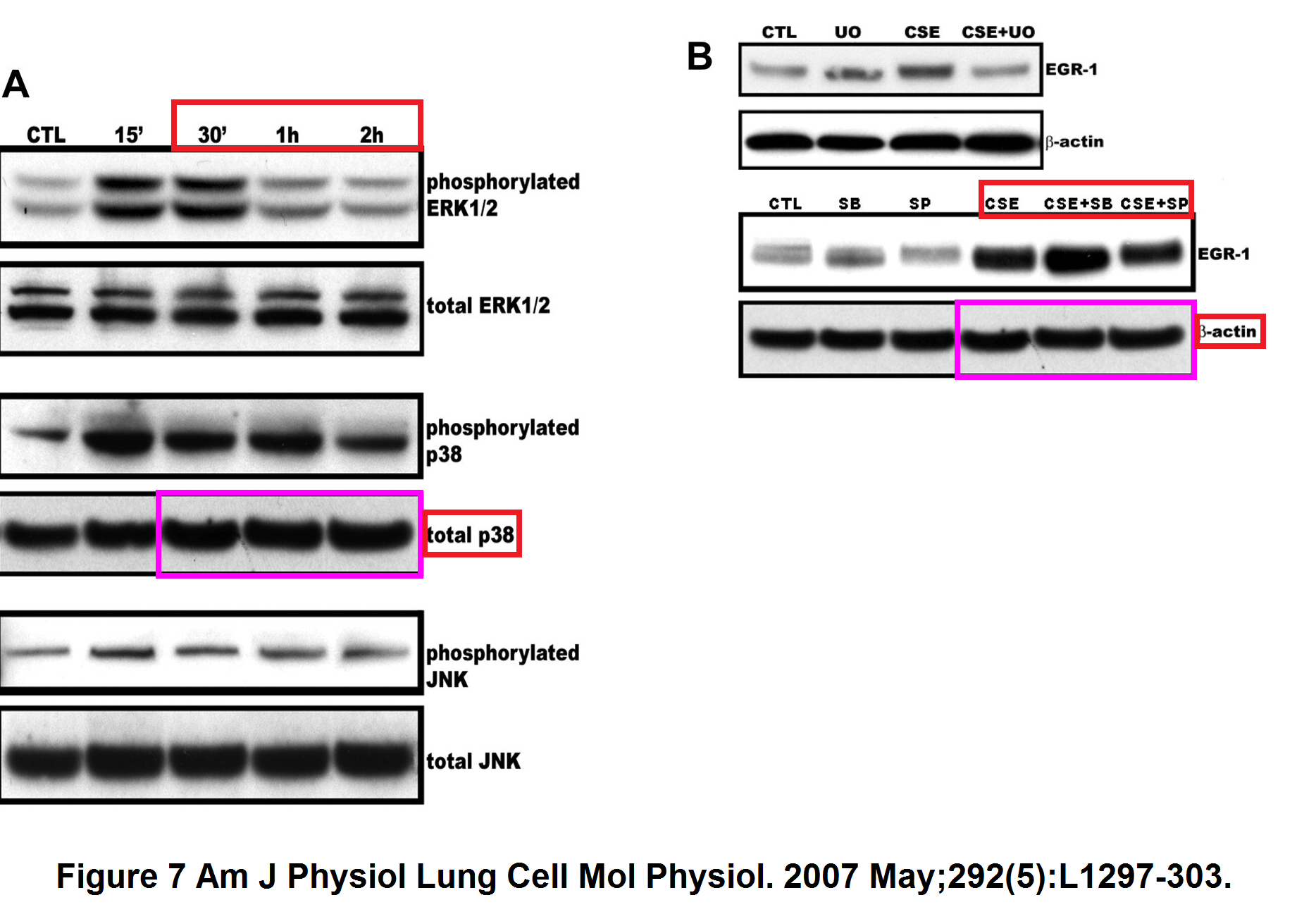

Next to reused western blot bands to fabricate loading controls in Figure 7, you can appreciate the detailed analysis of Figure 4A, where a band was obviously digitally copy-pasted onto an empty background. The Figure 5 in the other Choi-Ferghali copro-duction is also worth appreciating:
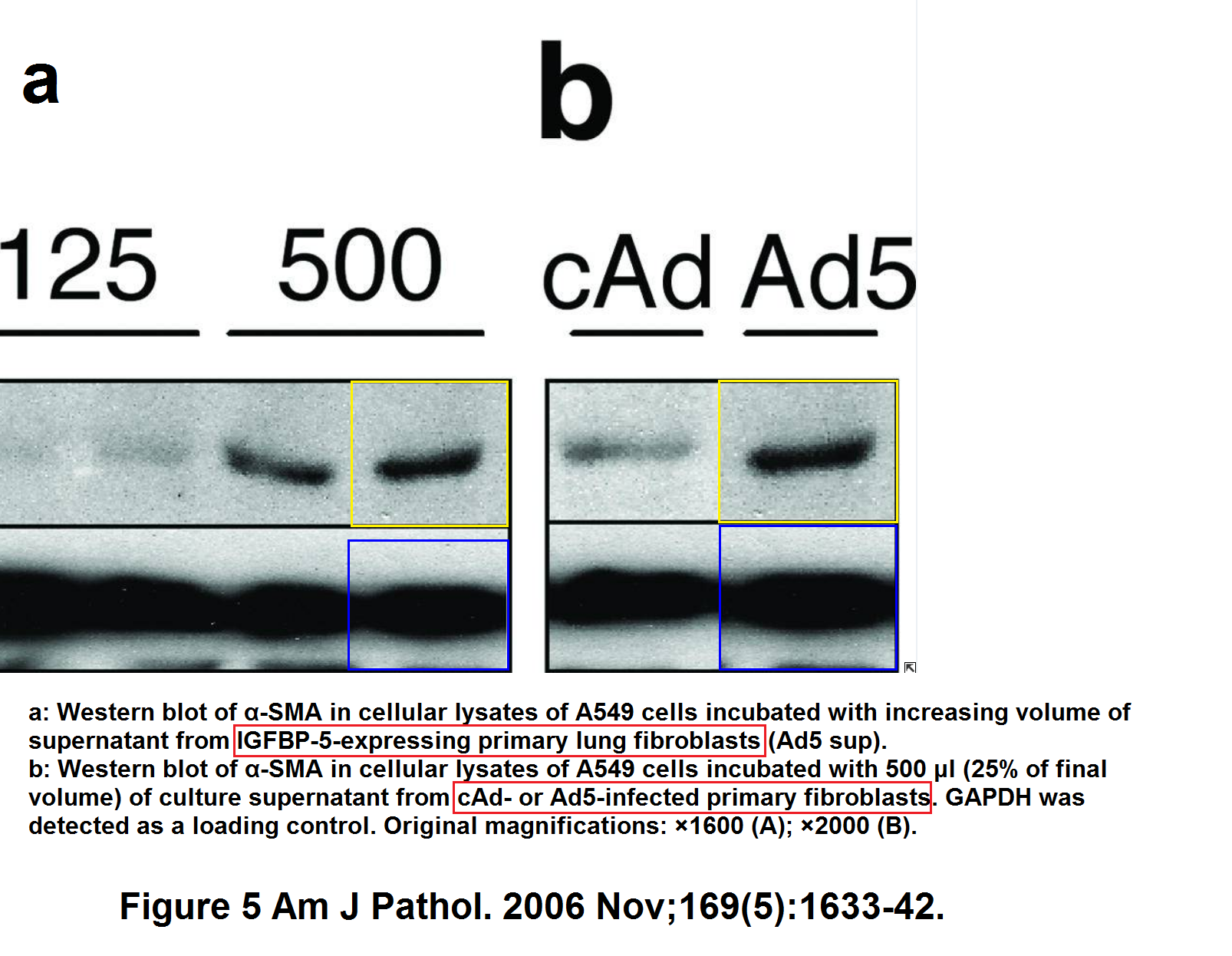
Hidekata Yasuoka, Zhihong Zhou, Joseph M. Pilewski, Tim D. Oury, Augustine M.K. Choi, Carol A. Feghali-Bostwick Insulin-like growth factor-binding protein-5 induces pulmonary fibrosis and triggers mononuclear cellular infiltration American Journal Of Pathology (2006) doi: 10.2353/ajpath.2006.060501
The quasi-Nobelist Choi so far had only one retraction, for “data discrepancies” of his lab’s paper Siempos et al Lancet Respiratory Medicine 2014. It was not a real retraction though, because a “corrected” version was republished right away, to replace the old one. But the next collaborative paper might get retracted despite Choi’s high status in US academia and medicine. It was published in collaboration witha certain Ross Summer, Choi’s pulmonology colleague from Thomas Jefferson University.
Freddy Romero, Xu Hong, Dilip Shah, Caleb B. Kallen, Ivan Rosas, Zhi Guo, DeLeila Schriner, Julie Barta, Hoora Shaghaghi, Jan B. Hoek, Clementina Mesaros, Augustine M. Choi , Nathaniel W. Snyder, Ross Summer Lipid Synthesis Is Required to Resolve Endoplasmic Reticulum Stress and Limit Fibrotic Responses in the Lung American Journal of Respiratory Cell and Molecular Biology (2018) doi: 10.1165/rcmb.2017-0340oc
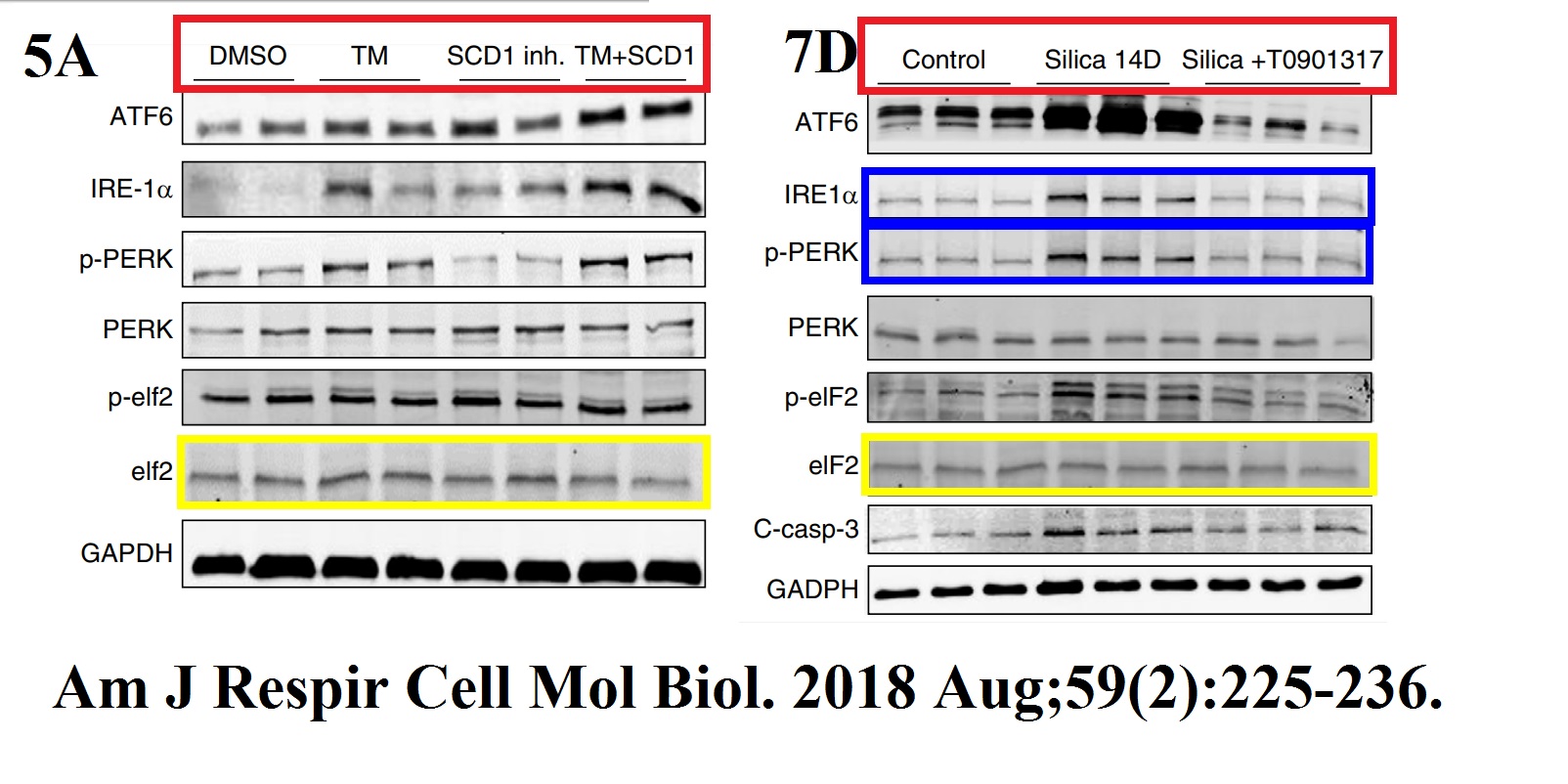
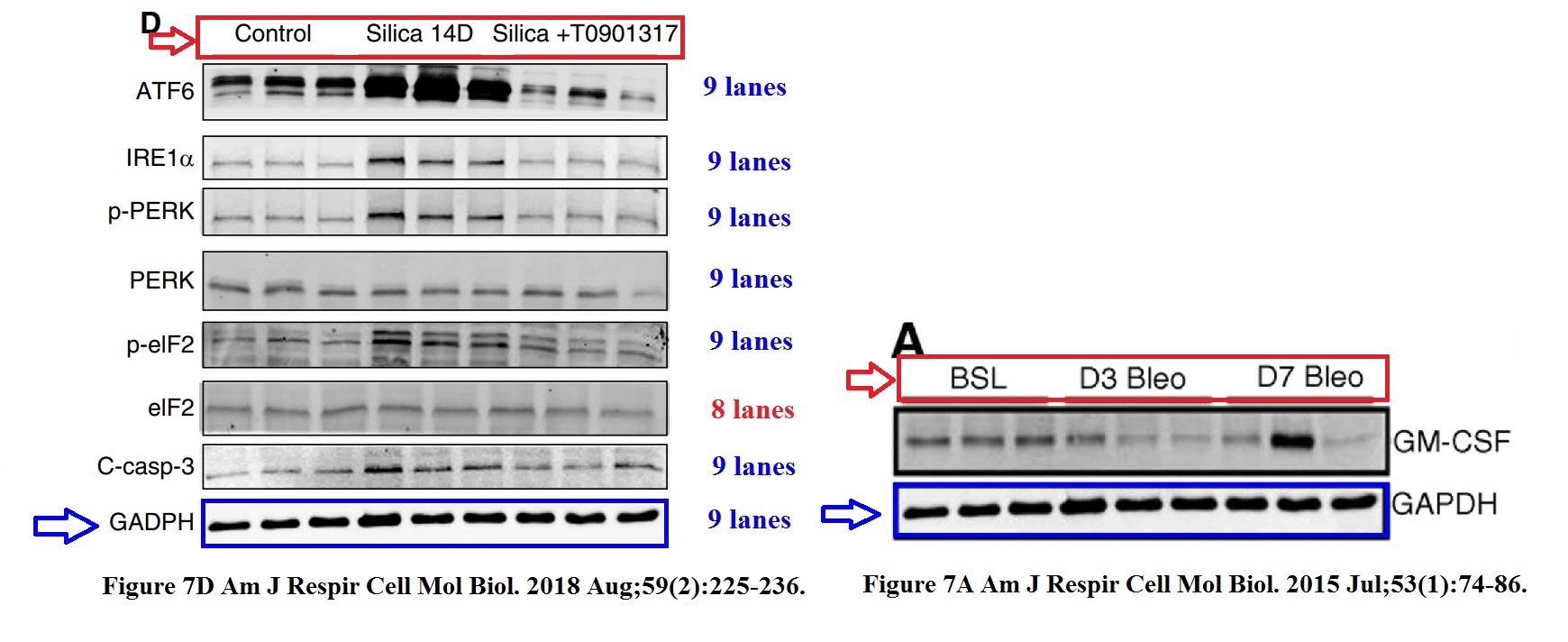
Summer namely has his own very shameful PubPeer record of ridiculously falsified data in (currently 6) papers from his lab. For one particularly hair-raising Photoshop production (Shah et al Scientific Reports 2015), Summer announced on PubPeer to share what he assumes to be raw data with the journal only.
Now, it is safe to assume that Choi’s groundbreaking discovery of carbon monoxide panacea is based on nothing else but Photoshop data fabrications in his lab. Who did those, in papers going back to more than 20 years, is up to you to guess. The only thing certain is that neither the medical school nor the university gives a flying toss, especially since Choi keeps pulling million-heavy grants, including for Weill Cornell (who recently received $2mn gift from Citadel investment bankers to study hydroxychloroquine to treat COVID-19).
This is what the office of the Cornell president wrote to Clare Francis when the latter tried to notify the university of the concerns with Choi’s papers:
“Please remove the Office of the President from these emails as our office is not involved in the matter.“
Which means: in the best case, Cornell expects the medical school head Choi to investigate himself. Now you probably also will understand why nobody will ever investigate the papers of the former Weill Cornell researchers, Andrea Cerutti and Paolo Casale.
What I personally think is less funny in this Choi affair, is the possibility reality of actual human patients being intubated with one of the most toxic gases, carbon monoxide, based on falsified research. Next to a phase 2 trial mentioned above, other CO trials have already happened, as Choi’s company Proterris proudly announces on their website:

Proterris raised enormous fund, including $21 million granted to Choi by NIH just for clinical trials, and expanded its operations. Really, why not using CO for COVID-19? Just Photoshop the results.
The STAT article from 2017 quotes Choi reminiscing about his CO discoveries:
“The first three to five years were hell. I thought my career might be over. But I believed in it. In research, you have to believe your data.“
Update 20.10.2020
You cannot imagine a better outcome of this affair. Dr Choi has been elected to the National Academy of Medicine!

Donate!
If you are interested to support my work, you can leave here a small tip of $5. Or several of small tips, just increase the amount as you like (2x=€10; 5x=€25). I am desperate to invest in carbon monoxide.
€5.00


Money, or scientific integrity? Which will Cornell choose?
It’s an easy one.
LikeLike
It seems this a way of working, at least, for some Cornell scientists. My ex-boss uses Photoshop and much more. You can appreciate his art by reading PubPeer comments.
LikeLike
This one? https://weillcornell.org/david-c-lyden-md-phd
https://pubpeer.com/search?q=david+lyden
LikeLiked by 1 person
Exactly!
Is so sad scientists like these get so much funding and no benefit at all for people. They should make original data available.
LikeLike
You ask for “original data”. What can be more original than data that is made up??
LikeLike
Lee Rudolph: you might be right. I think I should say “raw” data and not “original”? I am not a native English speaker.
Honestly, I think these researchers from Cornell University should instead publish science fiction books instead. I am sure they would get the same level of income they get nowadays.
LikeLike
https://news.weill.cornell.edu/news/2020/08/dr-lewis-cantley-honored-with-dr-paul-janssen-award-for-biomedical-research
Pubpeer comments on Lewis Cantley’s publications.
https://pubpeer.com/search?q=lewis+cantley
Often committed with C Ronald Kahn.
https://retractionwatch.com/2017/04/25/harvard-diabetes-researcher-retracts-third-paper/
LikeLike
https://meyercancer.weill.cornell.edu/about/leadership
Andrew J. Dannenberg, M.D.
Associate Director of Cancer Prevention
Pubpeer comments on data.
https://pubpeer.com/search?q=dannenberg
https://retractionwatch.com/2020/01/03/prominent-cancer-researcher-loses-eight-papers-making-11/
“Prominent cancer researcher loses nine papers, making 10”.
It’s a winning strategy!
LikeLike
Weill Cornell to the fore!
https://retractionwatch.com/2022/06/03/former-weill-cornell-cancer-researcher-up-to-20-retractions-investigations-findings-are-with-feds/
LikeLike
IMO, Medical school deans should not be allowed to “run” labs. Reason: I put “run” in quotes.They are not paying attention to what is going on, they just nod their heads and smile when the cheap labor in the lab “generates” data consistent with their hypotheses.That’s all they can do with all the responsibilities they have. The lab is just likely to fill their ego that they are truly physician scientists, who get to hob nob with the the medical elite (Fauci). Its all Hollywood, as Mr. Wong-Stahl in “Science Fictions” suggests.
Maybe CO will amount to something, but its impossible to know with this crappy data. You should look at Bob Furchgott’s (the discoverer of EDRF, also known as NO) old papers (like Ive done). Good clean science, which lead to the Discovery of NO. This CO crap–who knows?
Maybe I, the bastardly NMH, can go to one of these meetings and after Choi presents, I can say: “Dr Choi”: you are no Bob Furchgott.” Anyone familiar with American politics will get this change of words.
LikeLike
I’ve read the NO papers too. These days those papers would be panned for a “lack of mechanism” – smooth muscle contraction measurements, organ baths, lots of speculation about what the relaxing factor could be. But that was when you could just publish your honest observations and were allowed to provide some discussion about what they might mean. I miss the old days.
LikeLike
I agree that medical school deans should stay away from research. The Dean of Medicine at the University of Kentucky was the PI of a relinquished NIH grant and corresponding author of a retracted publication with alleged fraudsters Xianglin Shi and Zhuo Zhang. Yes somehow he managed to convince the university that he wasn’t culpable for any of this although paradoxically hundreds of faculty investigators who report to him would be expected to exercise due diligence and to suffer the consequences if they didn’t.
Interesting fact: Augustine Choi did his undergraduate education at the University of Kentucky. But he doesn’t talk about it preferring to emphasis his associations with more “prestigious” institutions.
LikeLike
If we can get Cheshire to photoshop Thomas Hunt Morgan and William Lipscomb (both U Ky undergrads, the later a nobel winner who was at Harvard) with Choi, say, with his arms around these guys, it might give him as serotonin high as great as when he was peced with Fauci. Then he might be a little more happy about his humble undergrad beginnings
Or better yet, put him in the pic of the table with the gaggle of Nobel prize winners at U Texas with Pepeys and Chairman Cao. That should do it.
LikeLike
I am sure there is a Cheshire/SmutClyde collaboration/detailed expose in the works. Dean Choi has several hundred publications so its going to take a while to sift through all of the figures.
LikeLike
Choi says he is “Looking forward to a new decade of excellence.” Excellence is not checking data to allow all of this carp to get published? That will keep The Oppilating Smut Man (TOSM) busy.
LikeLike
The commenters give my Photoshop skills too much credit.
“Cheshire”
LikeLike
Any undergraduate student (1st or 2nd year) who takes a basic quantum chemistry class should be able to explain why CO (carbon monoxide) binds more easily than O2 (dioxygen) to hemoglobin, and thus can kill you quickly. This is a customary question that is often asked in tests and that can be understood from the electronic structure of these molecules that students learn to construct. In France even 1st year medical students learn that, though in less detail. I am wondering what trained chemist would then believe that CO inhalation would cause no harm? CO has to be delivered in some other way possibly to do something beneficial. As for NO (nitric oxide), the difference with CO is just one electron. But as a student would tell you, this makes a huge difference in terms of how these molecules may bind to receptors or react.
LikeLike
NO and CO are for namby-pambys. I have been getting great results with CN. Treats all infections and chronic conditions with 100% efficacy. Trump will be endorsing it any day now.
LikeLike
J Clin Invest. 2013 Dec;123(12):5212-30. doi: 10.1172/JCI69636. Epub 2013 Nov 8.
Problematic data figure 9B. Much more similar than expected.
Histone deacetylase 6-mediated selective autophagy regulates COPD-associated cilia dysfunctionHilaire C. Lam,1,2,3 Suzanne M. Cloonan,1 Abhiram R. Bhashyam,1 Jeffery A. Haspel,1,4 Anju Singh,5 J. Fah Sathirapongsasuti,6,7 Morgan Cervo,8 Hongwei Yao,9 Anna L. Chung,1 Kenji Mizumura,1 Chang Hyeok An,1 Bin Shan,10 Jonathan M. Franks,11 Kathleen J. Haley,1 Caroline A. Owen,1 Yohannes Tesfaigzi,3 George R. Washko,1 John Quackenbush,6,7 Edwin K. Silverman,12 Irfan Rahman,9 Hong Pyo Kim,1,13 Ashfaq Mahmood,8 Shyam S. Biswal,5 Stefan W. Ryter,1,3 and Augustine M.K. Choi1
Author information
1Division of Pulmonary and Critical Care Medicine, Brigham and Women’s Hospital and Harvard Medical School, Boston, Massachusetts, USA. 2Department of Pathology, University of Pittsburgh School of Medicine, Pittsburgh, Pennsylvania, USA. 3Lovelace Respiratory Research Institute, Albuquerque, New Mexico, USA. 4Pulmonary and Critical Care Medicine Section, VA Boston Healthcare System, Boston, Massachusetts, USA. 5Department of Environmental Health Sciences, Johns Hopkins University, Bloomberg School of Public Health, Baltimore, Maryland, USA. 6Department of Biostatistics, Harvard School of Public Health, Boston, Massachusetts, USA. 7Department of Biostatistics and Computational Biology, Dana-Farber Cancer Institute, Boston, Massachusetts, USA. 8Department of Radiology, Brigham and Women’s Hospital and Harvard Medical School, Boston, Massachusetts, USA. 9University of Rochester, Environmental Medicine, Rochester, New York, USA. 10Department of Medicine, Tulane University School of Medicine, New Orleans, Louisiana, USA. 11Center for Biological Imaging, University of Pittsburgh, Pittsburgh, Pennsylvania, USA. 12Channing Laboratory, Brigham and Women’s Hospital, Boston, Massachusetts, USA. 13School of Pharmacy, Ajou University, Suwon, Republic of Korea.Address correspondence to: Augustine M.K. Choi, Department of Medicine, Weill Cornell Medical College, 525 East 68th Street, Room M-522, Box 130, New York, New York 10065, USA. Phone: 212.746.4720; Fax: 212.746.8793; E-mail: ude.llenroc.dem@6502cma.Authorship note: Hilaire C. Lam and Suzanne M. Cloonan contributed equally to this work.
LikeLike
2020 correction for J Clin Invest. 2013 Dec;123(12):5212-30.
https://www.jci.org/articles/view/143863
During the preparation of this manuscript, two panels of Figure 9B were inadvertently duplicated, resulting in an incorrect image for the ES group.
LikeLike
Pingback: How David Ojcius and Jie Yan solved Leptospirosis – For Better Science
nice catch, Zebedee. No doubt, the two images are strictly identical. BTW, the staining itself is utterly unconvincing, nothing but unspecific background.
LikeLike
Pingback: Fidarsi, ma verificare - Ocasapiens - Blog - Repubblica.it
Choi’s twitter feed is a delight to go through. I am very entertained by how he likes to have a picture of himself, with this super-confident look in a suit, next to a person of himself and a famous person. Good advertisement for serotonin injections or at least how prozac may make you feel. Also, he may be prescient in knowing who his pubpeer collaborators in the future will be:
LikeLike
” Diversity brings excellen(t fraud)” I think Choi should consider tackling retirement.
LikeLike
Much more similar than expected.
Fresh analysis:-
1. Med Gas Res 2011 May 18;1(1):8. doi: 10.1186/2045-9912-1-8. Harvard paper.
2. J Biol Chem. 2007 Jan 19;282(3):1718-26. doi: 10.1074/jbc.M607610200.
3. Mol Cell Biol. 2005 Jun;25(11):4742-51. doi: 10.1128/MCB.25.11.4742-4751.2005.
Much more similar than expected.
LikeLike
“This is what the office of the Cornell president wrote to Clare Francis when the latter tried to notify the university of the concerns with Choi’s papers:
“Please remove the Office of the President from these emails as our office is not involved in the matter.“”
https://news.weill.cornell.edu/news/2017/01/dr-augustine-mk-choi-named-dean-of-weill-cornell-medicine
“Dr. Augustine M.K. Choi Named Dean of Weill Cornell Medicine
JANUARY 17, 2017”
“I send my warmest congratulations to Dr. Augustine Choi on his appointment as dean,” said Martha E. Pollack, who will become Cornell’s 14th president April 17. “I am deeply impressed by his intellect, his candor, and his obvious passion for advancing Weill Cornell Medicine’s mission in patient care, discovery and education. I look forward to furthering collaborations across campuses and to working jointly with him to enhance the university’s strengths in the life sciences.”
Had Martha E. Pollack, or any of her advisors, looked at Ausgustine Choi’s data?
“The 19-member search committee, led by Rawlings and Jessica M. Bibliowicz, chairman of the Weill Cornell Medicine Board of Overseers, included board members and senior administrators from Cornell and Weill Cornell Medicine, faculty, alumni and NewYork-Presbyterian leadership. Choi was unanimously elected to his new position today by Weill Cornell Medicine’s Board of Overseers and the Executive Committee of the Cornell University Board of Trustees.”
Had any of the 19-member search committee, Weill Cornell Medicine’s Board of Overseers or the Executive Committee of the Cornell University Board of Trustees, looked at Augustine Choi’s data?
LikeLike
J Exp Med. 2006 Sep 4;203(9):2109-19. doi: 10.1084/jem.20052267. Epub 2006 Aug 14.
Carbon monoxide reverses established pulmonary hypertension
Brian S Zuckerbraun 1, Beek Yoke Chin, Barbara Wegiel, Timothy R Billiar, Eva Czsimadia, Jayashree Rao, Larissa Shimoda, Emeka Ifedigbo, Shin Kanno, Leo E Otterbein
Affiliation
1
Department of Surgery Transplant Center, Beth Israel Deaconess Medical Center, Harvard Medical School, Boston, MA 02215, USA.
Problematic data figure 3. Much more similar than expected.
LikeLike
J Exp Med. 2005 Dec 19;202(12):1703-13. doi: 10.1084/jem.20051047.
Carbon monoxide ameliorates chronic murine colitis through a heme oxygenase 1-dependent pathway
Refaat A.F. Hegazi, Kavitha N. Rao, Aqila Mayle, Antonia R. Sepulveda, Leo E. Otterbein, Scott E. Plevy
Author and Article InformationRefaat A.F. Hegazi1Department of Medicine, University of Pittsburgh, Pittsburgh, PA 15261Kavitha N. Rao2Department of Immunology, University of Pittsburgh, Pittsburgh, PA 15261Aqila Mayle1Department of Medicine, University of Pittsburgh, Pittsburgh, PA 15261Antonia R. Sepulveda3Department of Pathology, University of Pittsburgh, Pittsburgh, PA 15261Leo E. Otterbein4Department of Surgery, Transplantation Center, Beth Israel Deaconess Medical Center, Harvard Medical School, Boston, MA 02215Scott E. Plevy1Department of Medicine, University of Pittsburgh, Pittsburgh, PA 152612Department of Immunology, University of Pittsburgh, Pittsburgh, PA 15261
Problematic data Figure 6C. Splicing in one panel, but not the other makes comparing between panels problematic.
LikeLike